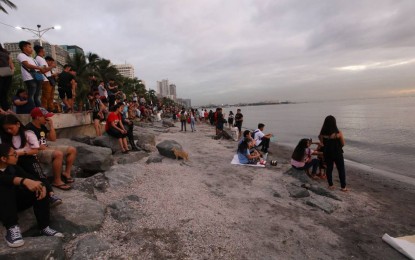
(PNA file photo of Manila Bay clean up)
MANILA – Experts crafting the sustainable development master plan for Manila Bay see the need to establish a resiliency fund for coastal local government units (LGUs) around this water body.
Such fund is for the LGUs' constituents occupying danger areas, noted University of the Philippines Los Baños professor, Dr. Rex Victor Cruz who is one of the experts working on the master plan.
“It’s for helping those exposed to flooding there opt to leave their places and live in safer areas instead,” he said.
He said there may be need for a law establishing the proposed resiliency fund if its budget will come from government.
“If it’s a grant, however, maybe there’ll be a different mechanism,” he said.
Establishing the fund is among proposed measures in the draft Manila Bay master plan he presented at a forum in Quezon City this week.
Such plan promotes activities for improving management of Manila Bay’s protected areas, enhancing solid waste management, reducing pollution load, addressing concerns of informal settlements in easements, enforcing sustainable fisheries and encouraging environmentally sound development.
The draft plan also promotes implementing disaster risk reduction and management initiatives like establishing the resiliency fund for Manila Bay’s coastal LGUs.
Cruz said these LGUs will determine who, in respective areas of jurisdiction, can avail of the fund.
“It’ll depend on how the LGUs choose their beneficiaries,” he said.
There’s need for LGUs concerned to establish criteria for identifying respective beneficiaries, he noted.
He isn’t discounting the possibility that amount of funding assistance for the beneficiaries will depend on their income level.
Crafting of the master plan for Manila Bay is under the auspices of National Economic and Development Authority (NEDA).
The plan aims to guide decision-makers in assessing and approving programs, activities and projects for implementation in Manila Bay and adjacent areas with significant influence on this water body, NEDA noted.
Manila Bay catchment accounts for some 53% of Philippine domestic products and hosts about 25 million people, said NEDA.
Given Manila Bay catchment’s socio-economic importance and complex situation, however, NEDA said having a master plan is imperative in guiding development within this area.
Hazards like flooding and environmental problems like pollution are among the area’s problems.
According to Cruz, work is in progress on further refining the draft Manila Bay master plan.
“We’ll submit the draft plan’s final version to NEDA around March next year for its review,” he said.
He expects in mid-2020 NEDA's decision regarding the final draft master plan. (PNA)
